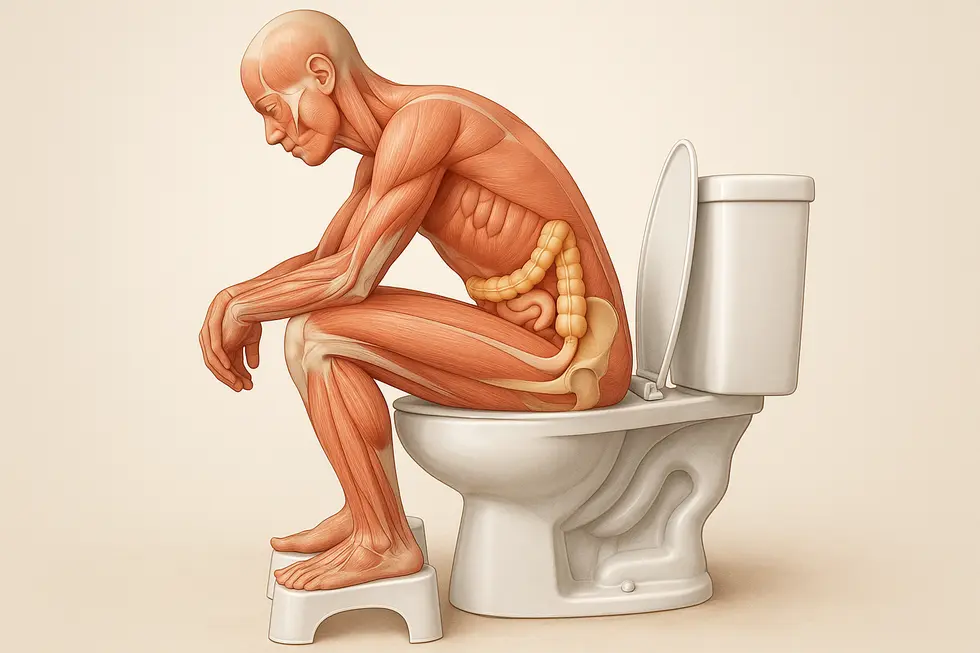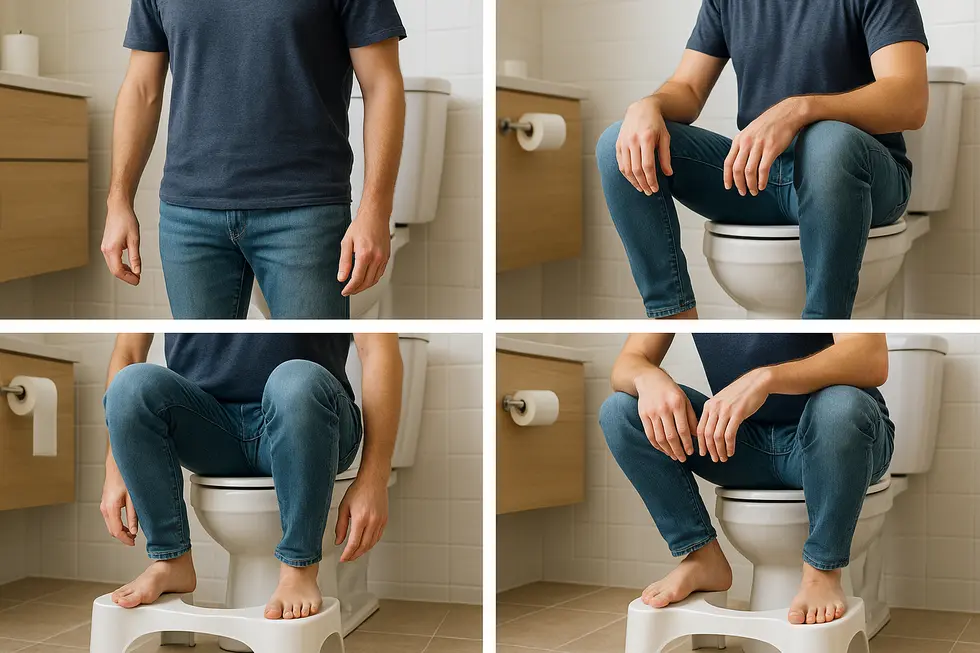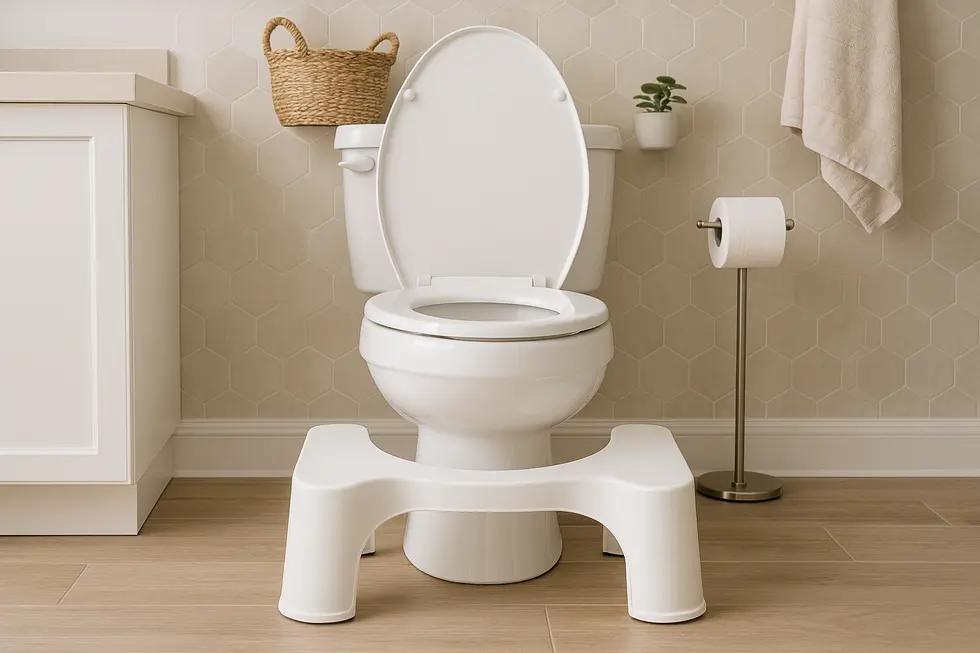Toilet Stools
Mastering Comfort: How to Use a Toilet Stool for a Healthier Family
The humble toilet stool is revolutionizing bathroom habits by promoting a healthier and more efficient way to go. This natural approach aligns our modern practices with the body’s design, offering significant wellness benefits for every family member. The upcoming chapters will delve into how toilet stools enhance health through biomechanics, provide practical use tips, and explore design and portability enhancements to improve your bathroom routine.
From Sitting to Squatting: Unlocking Biomechanical and Health Gains with a Toilet Stool

When you slide your feet onto a toilet stool, you are not just adding a footrest—you are rewiring bathroom biomechanics. Elevating the feet tilts the pelvis forward, shrinking the hip angle from a rigid 90-degree chair-sit to a more open 35-40 degrees that mimics a deep squat. In this position, the puborectalis muscle, which normally cinches the rectum like a drawstring, slackens. The rectal tube straightens, creating a clear, almost gravity-assisted path for waste to exit. Many first-time users notice the difference immediately: less straining, a shorter stay, and a sense of “complete emptying” that sitting alone rarely delivers.
This subtle postural shift also gives joints a quiet workout. Ankles dorsiflex, knees flex, and hips externally rotate—micro-movements that counteract the stiffness built up by long hours of conventional sitting. Over time, these daily micro-squats can improve lower-body mobility and may even ease mild back or hip discomfort linked to poor toilet ergonomics.
Health benefits extend beyond comfort. Reduced straining helps protect delicate anal tissues, lowering the risk of hemorrhoids and fissures. Pelvic-floor therapists often recommend a stool to clients dealing with dysfunction because relaxing the puborectalis prevents the “push and tuck” pattern that aggravates weakness. People troubled by chronic constipation frequently report more regular, complete evacuations once the stool becomes part of their routine, an effect attributed to smoother colonic emptying and less intra-abdominal pressure.
Even individuals managing pain or limited strength gain relief; the body no longer fights against its own anatomy to move the bowels. For caregivers, this can translate into fewer bathroom accidents and simpler assistance, especially when paired with supportive devices such as grab bars.
For a deeper dive into how proper leg elevation enhances elimination, see this comprehensive guide on toilet stool posture benefits.
Clinicians continue to highlight these advantages; one overview explains why therapists champion the humble stool for everything from constipation to pelvic rehab (https://cmtmedical.com/why-therapists-should-champion-the-humble-toilet-stool/). Adopting a toilet stool, therefore, is less a novelty than a return to human design—an easy, evidence-backed upgrade that turns every visit to the toilet into a small act of biomechanical self-care.
Mastering the Squat: Step-by-Step Posture for Optimal Toilet Stool Use

When you place a toilet stool in front of the commode, think of it as a miniature hiking trail that lifts you from a rigid 90-degree seat into a gentle squat. Slide the stool until its curve hugs the porcelain; this positions your feet flat and stable the moment you sit. With soles planted, your knees rise above hip level—a ten-second adjustment that unlocks smoother elimination.
Lean forward from the hips while keeping the spine long, as though offering a polite bow. Resting elbows on thighs adds stability and engages your core without effort. Because the hips are flexed, the puborectalis sling slackens, straightening what is usually a kinked rectal pathway. Many users feel a subtle “unlock” sensation; that is the rectal angle opening.
Breathe slowly through the nose. Resist the habit of holding breath and bearing down—the posture supplies passive abdominal pressure. If movement feels sluggish, add a gentle rock or torso twist; this self-massage stimulates peristalsis without force. Feet must stay grounded; dangling toes re-introduce tension. Should the stool feel too low or high, review the posture benefits of a toilet stool and consider an adjustable height.
Remain only as long as necessary. Extended sitting, phone scrolling, or slouching rounds the back and collapses pelvic organs, erasing the gains you just earned. Once finished, slide the stool back under the toilet or against the wall so others can use the seat normally and the space stays uncluttered.
Consistent practice trains muscle memory; within days you will instinctively place the stool, set your feet, and lean forward in one fluid motion. Over time many people report less bloating, fewer hemorrhoid flare-ups, and reduced constipation—a testament to how a small change in angle can realign centuries of human physiology with modern plumbing. For travelers, a lightweight, foldable option such as this portable, travel-friendly stool delivers the same benefits on the road.
Finding the Right Fit: Design and Portability Essentials for Mastering the Toilet Stool Posture

Even the perfect squatting posture feels awkward when you perch on a stool that is the wrong shape or too bulky to move. Understanding design variations—and why they matter—turns a simple plastic accessory into a reliable daily tool for healthier elimination.
Shape, size, and harmony with your toilet
Standard toilets are either round or elongated, and stool manufacturers mirror those curves. A compact 16-inch round model tucks neatly beneath smaller bowls, freeing floor space in studio apartments. Longer 18-inch elongated versions give broader footing, a welcome upgrade for taller users or anyone who needs extra knee spread to ease pelvic tension. Measuring the front lip of your bowl before buying spares you the wobble that comes from forced alignment.
Comfort layers for sensitive sitters
Bare plastic suffices for most, but anyone with tender joints, neuropathy, or who simply enjoys a plush feel may appreciate memory-foam or gel inserts. The cushioning disperses pressure on the arches so the feet can stay relaxed, allowing the puborectalis muscle to release fully without the distraction of sore soles.
Height and attachment security
An ideal height lifts the knees to roughly 35°. Fixed-height models work for average statures, yet families with children or multi-user bathrooms often prefer an adjustable toilet stool so each person can dial in their angle. Regardless of height, check the grip: non-slip feet or clip-on rails prevent shifting that could re-engage abdominal bracing—exactly what the stool is meant to avoid.
Portability: because digestion doesn’t take vacations
Lightweight polypropylene units tip the scale at under three pounds, making them easy to slide against the wall or drop in a tote. Frequent travelers might prefer folding frames that collapse flat, nestling beside a laptop inside carry-on luggage. Wood and metal builds can last decades, yet their heft confines them to home use and can scratch tile if dragged. When portability is vital, look for rounded edges, integrated handles, and materials that rinse clean quickly after hotel-room use.
Balancing these design and mobility factors ensures the stool disappears from conscious thought, letting biology take center stage and bowel movements flow with minimal effort. (External reference: https://cmtmedical.com/why-therapists-should-champion-the-humble-toilet-stool/)
Final thoughts
Incorporating a toilet stool into your family’s bathroom routine can significantly enhance comfort and health. By understanding the biomechanical benefits, utilizing proper techniques, and selecting the right design, you can ensure easier and more efficient bathroom experiences. Embrace the simplicity and effectiveness of toilet stools to promote better digestive health and overall well-being for your family.
Experience a new standard of clean with PEGABidet—designed for comfort, safety, and independence. Join thousands who trust us to make personal care simple and dignified. Contact us contact@pegabidet.com
About us
PEGABidet is a brand owned by L.A NEXTGEN LLC, based in California. We design intuitive, hygienic, and accessible bathroom solutions that prioritize safety, dignity, and independence. Our mission is to make personal care effortless and empowering for people at every stage of life.

